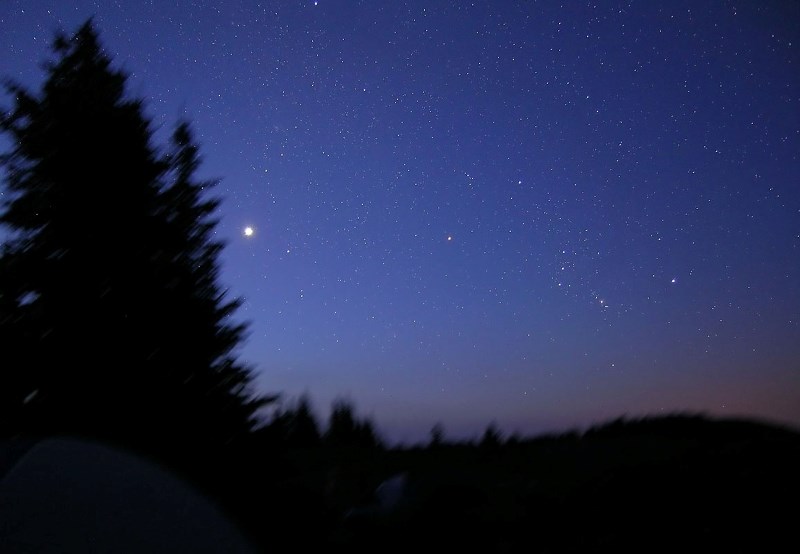Back when I still lived in my old house, there was an old friend that would drop by to visit every winter night. As the snow crunched beneath my feet after a late day at work, I knew that I needed only to look above the rooftop to spot the constellation Orion flexing his biceps in the moonlight.
It wasn’t always easy to spot him, of course. Sometimes it was cloudy, and other times his stars would keep shifting and wavering about.
That shifting and wavering is called twinkling, or scintillation, explains Bruce McCurdy, volunteer astronomer at the Telus World of Science in Edmonton. It’s an optical effect caused by turbulence in the Earth’s atmosphere.
The atmosphere is full of lumps and layers of air at different temperatures and densities, says St. Albert astronomer Murray Paulson. As starlight passes through these layers, it shifts, refracts and sometimes even splits, prism-like, altering the star’s apparent brightness, position and colour.
It’s like looking at a rock under a rushing river, McCurdy explains.
“It’s the actual movement of the water that causes the illusion of the rock moving.”
The amount of twinkling generally depends on the amount of atmospheric turbulence, Paulson says. A calm night will cause virtually none. A wild one can set the whole sky shimmering.
“That’s a really strange effect. It can make you feel like you’re the one who’s moving around.”
Stars themselves are massive balls of gas and plasma undergoing fusion. They look point-sized to us, but are typically millions of kilometres wide. Our sun is 1.4 million kilometres wide, for example, while Betelgeuse (the right shoulder of Orion) is even bigger.
“Its diameter is thought to be on the scale with the orbit of Mars,” McCurdy says of Betelgeuse.
“If Betelgeuse was where the sun is, we’d be inside of it.”
Stars only look small because they’re really far away. McCurdy says our sun is about eight light minutes from Earth (about 150 million kilometres), while most of the ones in the night sky are thousands of light years away.
Stars produce different colours of light depending on their temperature, McCurdy notes. Betelgeuse is reddish because it burns at about 4,000 degrees Kelvin. Our 6,000 K sun produces yellow light, while smoking hot Rigel (11,000 K) makes blue.
The twinkling effect can cause these stars to cycle through all the colours of the rainbow, especially when it comes to a really bright star like Sirius, Paulson says.
“It is really quite the spectacle.”
Stars viewed near the horizon will twinkle more than those that are right above you, Paulson continues. The starlight has more atmosphere to pass through at the horizon, which means more distortion.
Curiously, it’s the brightest stars that appear to twinkle the most.
The fault here lies not in the stars but in ourselves, Paulson reports.
When we look at a faint star, our eyes need more time to process the light from them. The result is like a long-exposure photo – the star blurs in our mind, which masks the twinkling. We notice bright stars twinkle because our eyes can image them quick enough for our brains to notice the shifts.
And the biggest stars in our sky twinkle the least, or not at all.
McCurdy says these are actually planets, and are close enough to us that they appear as cylinders rather than pinpoints of light. Because the distortion effect of the atmosphere is so subtle, the tiny changes in the light from these planets tend to get averaged out across the whole light cylinder. (You can still see the effect if you look at the surface of these planets with a telescope, he adds.)
Twinkling looks nice, but is kind of annoying if you want a clear image of a star.
The only way to eliminate it completely is to go into space, Paulson says – that’s the whole point behind space telescopes. Otherwise, you need expensive computerized adaptive optics that can compensate for the twinkling effect.
I don’t see Orion as often at my new place – it’s downtown, and the buildings are taller. But whenever I do, I still pause to wave hello and compliment him on his sparkling stars.
Scientific St. Albert
Like science? So do we! Scientific St. Albert looks at a simple, common phenomenon in the St. Albert region and explains it with the help of local scientists every other week. <br />Got a burning scientific question? Send it in to [email protected].




